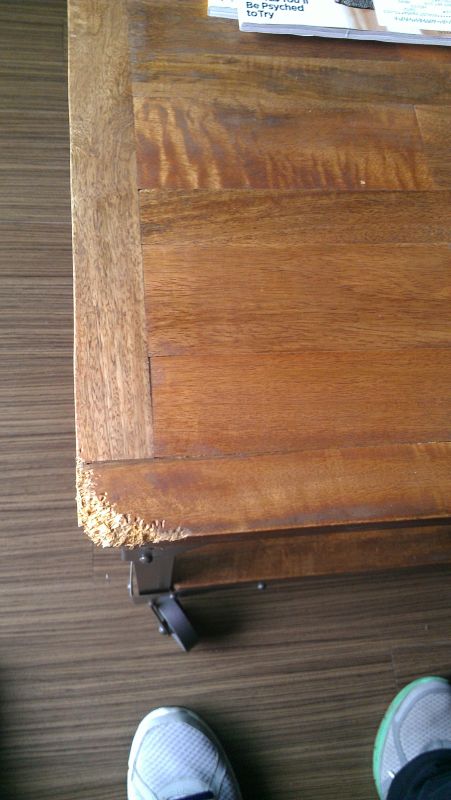Repairing Dog-Chewed Furniture
Woodworkers suggest various post-canine repair strategies for a table top. June 30, 2014
Question
Does anyone know for sure what type of wood this is below? I can guess, but would like to hear some other professional opinions. Also, how would you go about repairing this? Again, it was chewed up by a dog and I have an idea of how I'd like to approach it, but I'm open to suggestions.

Click here for higher quality, full size image
Forum Responses
(Finishing Forum)
From contributor I:
I would replace that entire trim piece for it to ever look right. Or you could cut that section out and try to find a wood with comparable grain to glue in. You still have to blend in. Even the best of touch up guys I know would have a challenge. Then have a good talk with the dog!
From contributor J:
The wood is mahogany. Epoxy is by Mohawk. You could use a Dutchman repair on all four corners to match.
From contributor M:
The epoxy from Mohawk is a good and quick way to repair that corner.
From contributor P:
I don't think that's mahogany. It's more likely one of those tropical woods that is labeled as mahogany these days. I'd build a new top (the right way) out of maple or something, and stain it to match. I think an epoxy repair on an exposed corner will just get chipped in normal use and will look terrible. My second option would be to sand and shape the corner until it looks somewhat presentable, touch it up and call it distressed.
From contributor R:
I would rip that edge off using either a tablesaw or a skillsaw with a straightedge and then use a board-stretcher to lengthen the old piece enough to cut off the damaged part, and then replace. If you don't have access to a board-stretcher then find a piece of wood that matches and replace it. Re-finishing should be pretty straight-forward.
From Contributor S:
Here is how a furniture technician would repair that. Mohawk sells an epoxy putty that looks like a Tootsie Roll. Use that material to fill the damage and rebuild the edge. Sand it to carve (you can use a heated sharp spatula to shave away cured chunks but beware that too much heat can also lift the cured epoxy putty from its hold on the wood). Use naphtha to lubricate your sandpaper (220 grit) and block sand. Try to only stay near the damage. Replacing the missing color is done with Mohawk's Blendal Sticks (specially formulated oil pastels made for use under lacquer topcoats). You can also color with Blendal powders and you can tie in the colors using aerosol toners, pigmented or dye.
Topcoat with Mohawk's aerosol vinyl sealer followed by their aerosol precat. I suggest the precat not because of durability but because the precat aerosols are unique in their ability to spot spray without creating too much if a halo. That's how a furniture tech would tackle this type of damage. All the other methods have effectiveness not because you heal the damaged area, those aren't methods of restoring to original condition. There's a good reason we tech's charge what we charge - the array of available materials and their uses is daunting to the initiated.
